|
|
|
|
 |

 |
|
The Tower
of Babel and Ziggurats
Is the
Tower of Babel account
in the Bible
reasonable?
Critics have long targeted Bible accounts such as the Tower of Babel.
An examination of the region, linguistics, and archaeological data
reveal evidence reasonably expected from the historical Biblical account.
Nine verses in Genesis 11 provide the entire story. A short
portion of the preceding chapter provides added context.
Genesis 11:1-9 Now the whole earth had one language and the
same words. 2 And as people migrated from the east, they found
a plain in the land of Shinar and settled there. 3 And they
said to one another, "Come, let us make bricks, and burn them
thoroughly." And they had brick for stone, and bitumen for mortar.
4 Then they said, "Come, let us build ourselves a city and a
tower with its top in the heavens, and let us make a name for
ourselves, lest we be dispersed over the face of the whole earth."
5 And the LORD came down to see the city and the tower, which the
children of man had built. 6 And the LORD said, "Behold,
they are one people, and they have all one language, and this is only
the beginning of what they will do. And nothing that they propose to
do will now be impossible for them. 7 Come, let us go down and
there confuse their language, so that they may not understand one
another's speech." 8 So the LORD dispersed them from there
over the face of all the earth, and they left off building the city.
9 Therefore its name was called Babel, because there the LORD
confused* the language of all the earth. And from there the LORD
dispersed them over the face of all the earth. (ESV)
Genesis 10:8-12 Cush fathered Nimrod; he was the first on earth
to be a mighty man. 9 He was a mighty hunter before the LORD.
Therefore it is said, "Like Nimrod a mighty hunter before the LORD."
10 The beginning of his kingdom was Babel, Erech, Accad, and Calneh,
in the land of Shinar. 11 From that land he went into Assyria
and built Nineveh, Rehoboth-Ir, Calah, and 12 Resen between Nineveh
and Calah; that is the great city. (ESV)
Much misinformation circulates in Christian churches over the Tower
of Babel. Renaissance artworks in the western world reflect
long held ideas of Christendom. Speculation regularly fuels
commentaries, Sunday school stories, cartoons, and sermons.
Common thoughts include:
#1. The entire world's population lived in one area or place.
The first time people split up and settled in other places was after
God confused their languages.
#2. Everyone on planet earth, at this time, spoke the exact same language.
#3. The tower of Babel was the first tower ever built.
#4. The tower of Babel was trying to reach into outer-space or to
where God lives.
#5. Since this was shortly after the flood, they wanted to build a
tower high enough to escape any future flood.
#6. The tower of Babel was at Babylon (in modern Iraq)
We will consider each of these claims, or ideas, using Scriptures and
archaeological evidence.
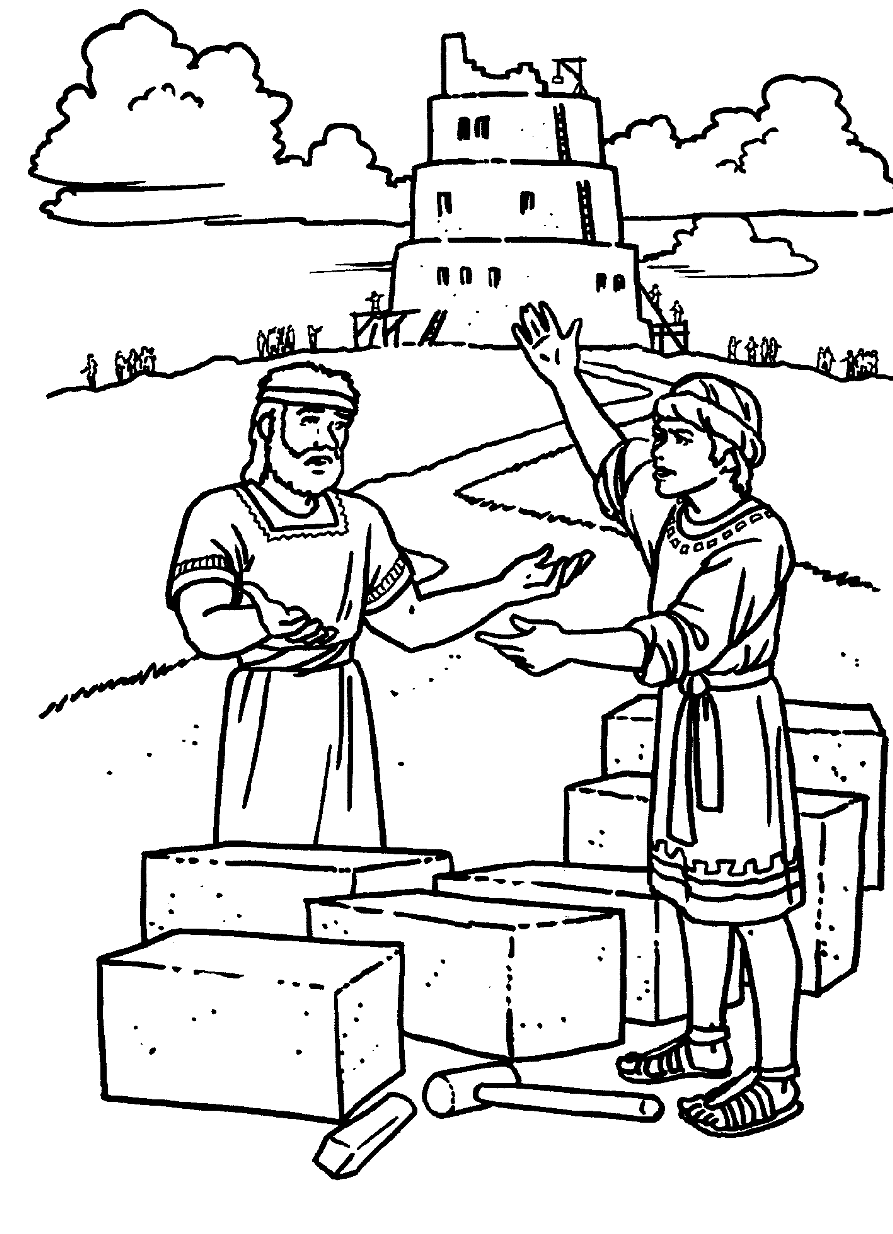 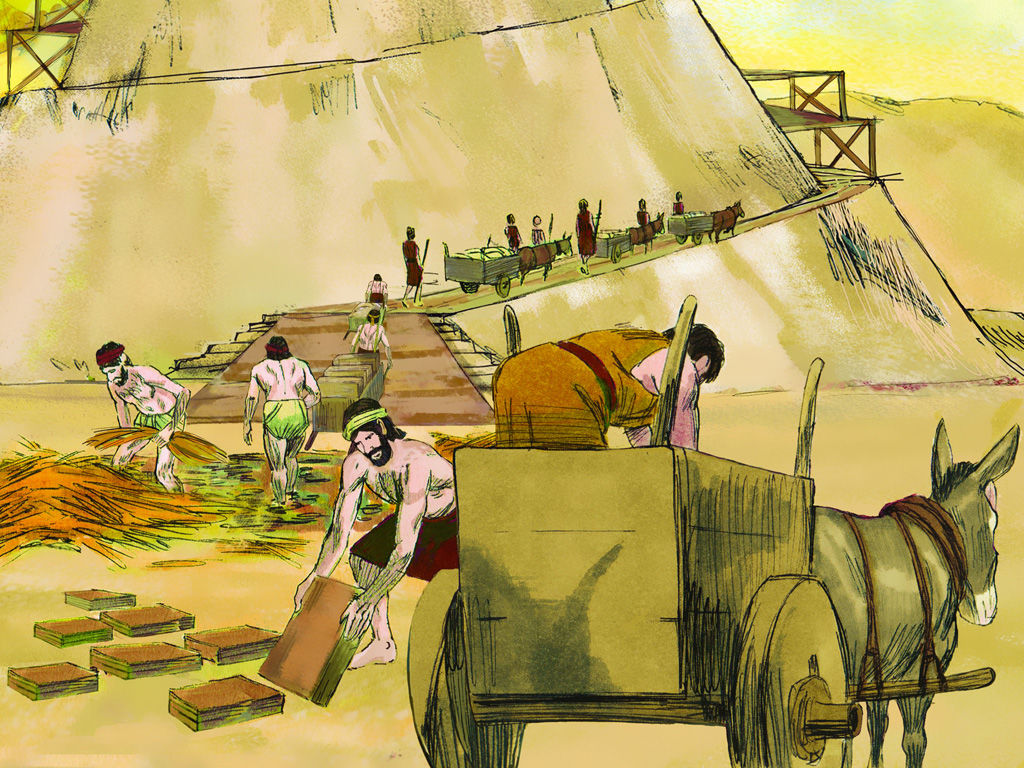
These
circulated Christian drawings are a source of error. The left shows
the tower built
with
stone, the right show them using mud-brick made with straw.
Both oppose
details
provided in the scriptural account.
Regional History
The region in view is the area of modern Iraq, Kuwait, and Iran,
often casually called Mesopotamia. The major ethnic division in
this region was Sumerian versus Elamite, both a division of language
and cultures. Before this great divide appeared, the region
featured one major people...
Sumerians
The Sumerian Empire arose in the flood plan of the lower Tigris and
Euphrates Rivers. At first the area had many independent city-states.
Each community included a priesthood ruling in the name of their
local god. Their armies existed to serve the priests and
protect the temple community. The rise of powerful warriors
finally led to unification and the rise of kings.
Archaeologists consider the Sumerian City of Eridu, on the coast of
the Persian Gulf, to be the world's first city.
Sumerians controlled the area of Mesopotamia from the time of Babel
until they fell, around 2270 B.C., to the Semitic-speaking kings of
their northern neighbor, the Akkadian Empire. The Akkadian
Empire (circa 2334-2154 B.C.) was mostly a continuation of the
Sumerians under new management. They kept the Sumerian language
as a sacred language, Akkadian was the daily language. In fact,
a brief resurgence of the Sumerian Empire occurred from 2100-2000
B.C. but the Akkadian language continued to be used during this time.
Following the Akkadian period, Assyria arose in the north and later
Babylonia in the south.
The Sumerian language appears unrelated to any other language in the world.
Sumerian literature refers to an original homeland called
"Dilmun," yet no one has been able to pinpoint this location.
Speculatively suggested regions are always outside neighboring areas,
including due east, because those areas have known names in other
contemporary languages. Dilmun may have been trying to refer to
an already known place now using a newly started language.
Because of Babel, the abrupt appearance of new regional root
languages makes this a reasonable and expected development.
Dilmun is likely a new name referring to a region in the Elamite or
Proto-Elamite area to their east (now Iran).
The Sumerians developed the oldest known written language in the
world (closely rivaled by Egyptian hieroglyphics). Its
cuneiform script, though cumbersome and imperfect, was copied by the
Elamites, Akkadians and Eblaites. Cuneiform was in widespread
throughout Persia and the Middle East for millennia.
Elamites
The Elamite Empire arose to the East of the Sumerians around 2700
B.C. (the rough dating of Babel). This empire survived for
thousands of years, until around 539 B.C., with periods of relative
strength or weakness. An earlier Elamite civilization existed
in the region (often called "Proto-Elamite"), including
early cities such as Susa, with a defined culture and art including
bronze making. Elamite is a now extinct language once spoken by
the ancient Elamites from around 2800 to 540 BC. The last written
records in Elamite appear about the time of the conquest of the
Persian Empire (331 B.C.) by Alexander the Great. Elamite has no
demonstrable relatives and linguists consider it a language isolate.
Its lack of relatives makes it difficult to interpret the language.
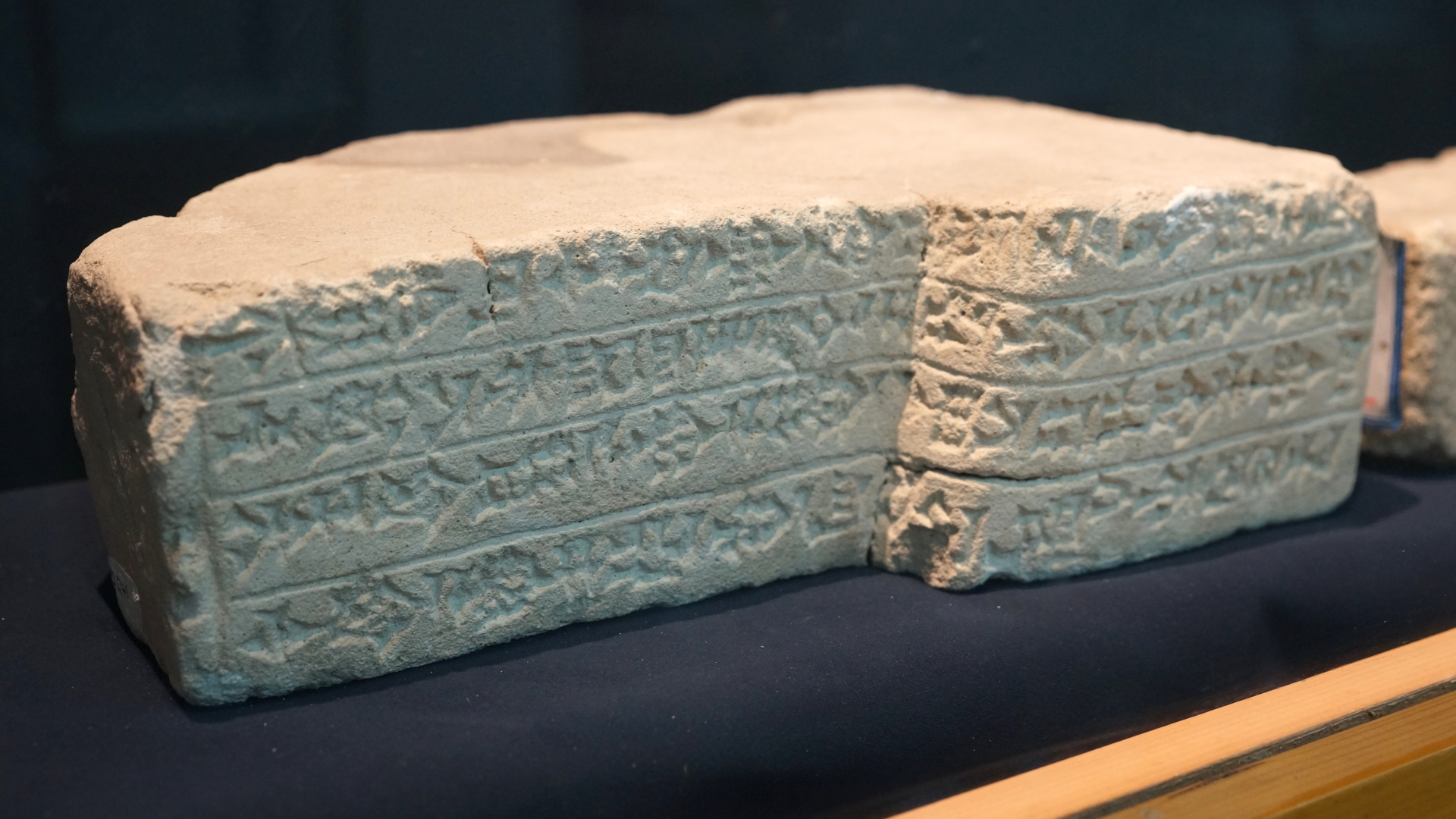
Elamite
cuneiform on a brick
The Land of Shinar
We know the Land of Shinar is in Mesopotamia based on the known
cities associated with the region in Genesis 10 & 11. Later
scriptures also reference the region:
The king of Shinar opposed Sodom and invaded Canaan in Genesis 14:1.
Daniel 1:1-2 (also Zechariah 5:11) has the land of Shinar associated
with the kingdom of Babylon (and its ruler Nebuchadnezzar).
This is likely referencing the land by the primary city and ruler of
Daniel's day.
Other known cities or defined areas include:
Erech - Uruk (modern Warka)
Nineveh (found on the eastern bank of the Tigris River in modern-day
northern Iraq. Its two archaeological tells, Kouyunjik and Nabi
Yunus, are on a level part of the plain near the junction of the
Tigris and the Khosr Rivers).
The Land of Nimrod. The prophet Micah uses Assyria as a
parallel to "the land of Nimrod" (Micah 5:6).
Many linguists view the word "Shinar" as a transliteration
of a Sumerian word meaning "Sumer-Akkad," or "the land
of Sumer and Akkad."

Ziggurats and their purpose
Ziggurats are large, distinctive, religious, brick buildings found
around Mesopotamia. There are 32 known ziggurats in the region,
built over two millennia, four in Iran and the rest in Iraq.
Ziggurats are not temples in a traditional sense. Priests did
not live in them or use them to perform rituals. Instead, they viewed
the ziggurat as a resting place for the gods. By building a ziggurat
near a major city, the rulers could ensure the gods stayed near,
offering their aid in battle and keeping the crops growing. The
Mesopotamian ziggurats were not places for public worship or
ceremonies. Each city's ziggurat hosted its own patron god. Only
priests walked on the ziggurat or visited rooms at its base,
ostensibly caring for the gods and attending to their needs. The
Mesopotamians believed that these pyramid temples connected heaven
and earth.
The Greek historian Herodotus (lived 484-425 B.C.) wrote that a
shrine topped each ziggurat, though none of these shrines have
survived intact.
|
|
Tepe Sialk
Ziggurats
appeared in the Proto-Elamite period (sometimes called the Early
Dynastic Period), which ended around 2700 B.C. (or 2500 using the
second label). The Tepe Sialk ziggurat, in Kashan, Iran, is the
oldest known, dating to around 3000-2900 BC. The entire
building is of mudbrick construction. People lived around the
Ziggurat, with the wealthy and powerful living closest on one side.
The opposite side was a burial area.

The
author at Tepe Sialk
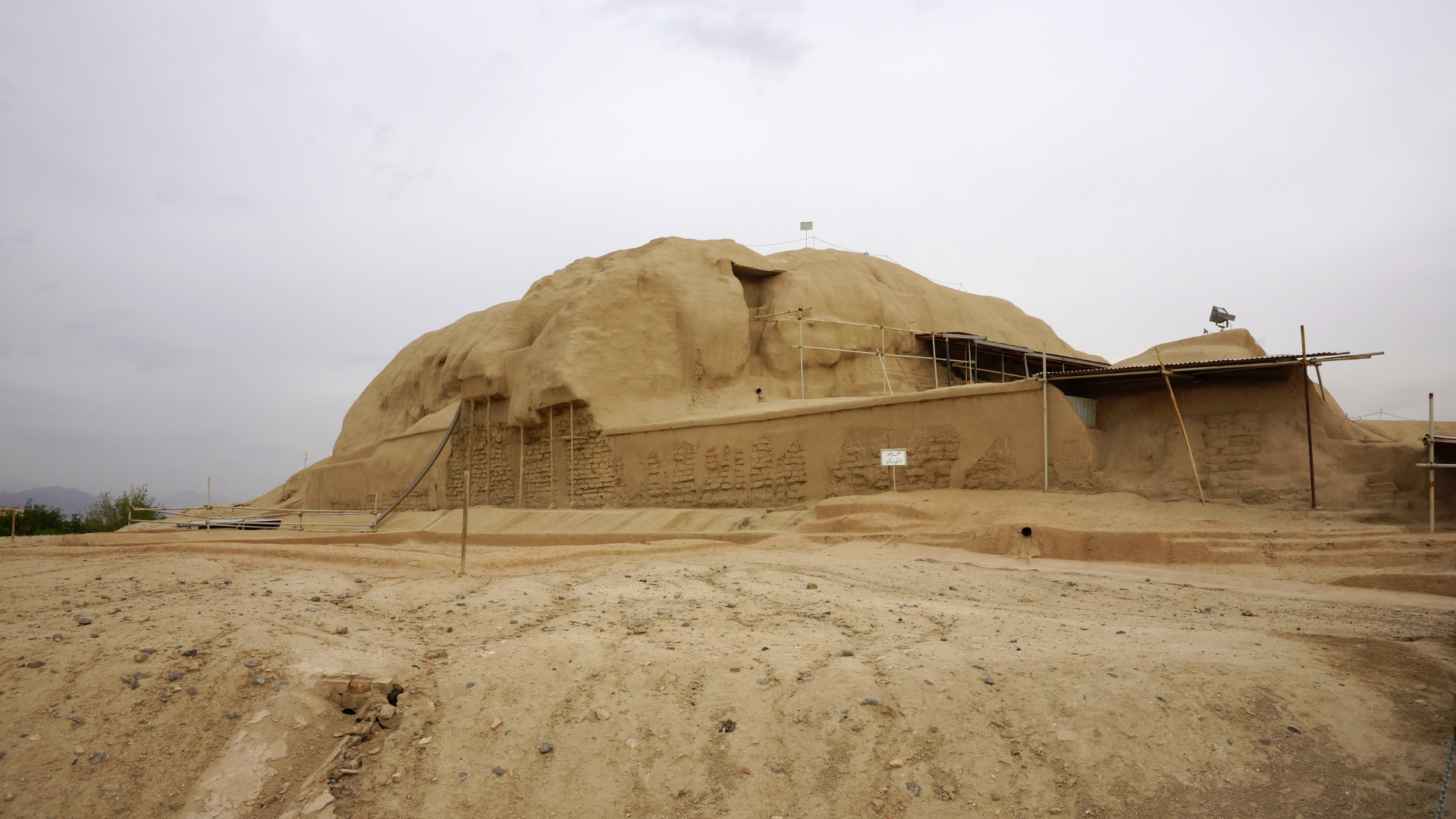
Moving
counterclockwise around Tepe Sialk
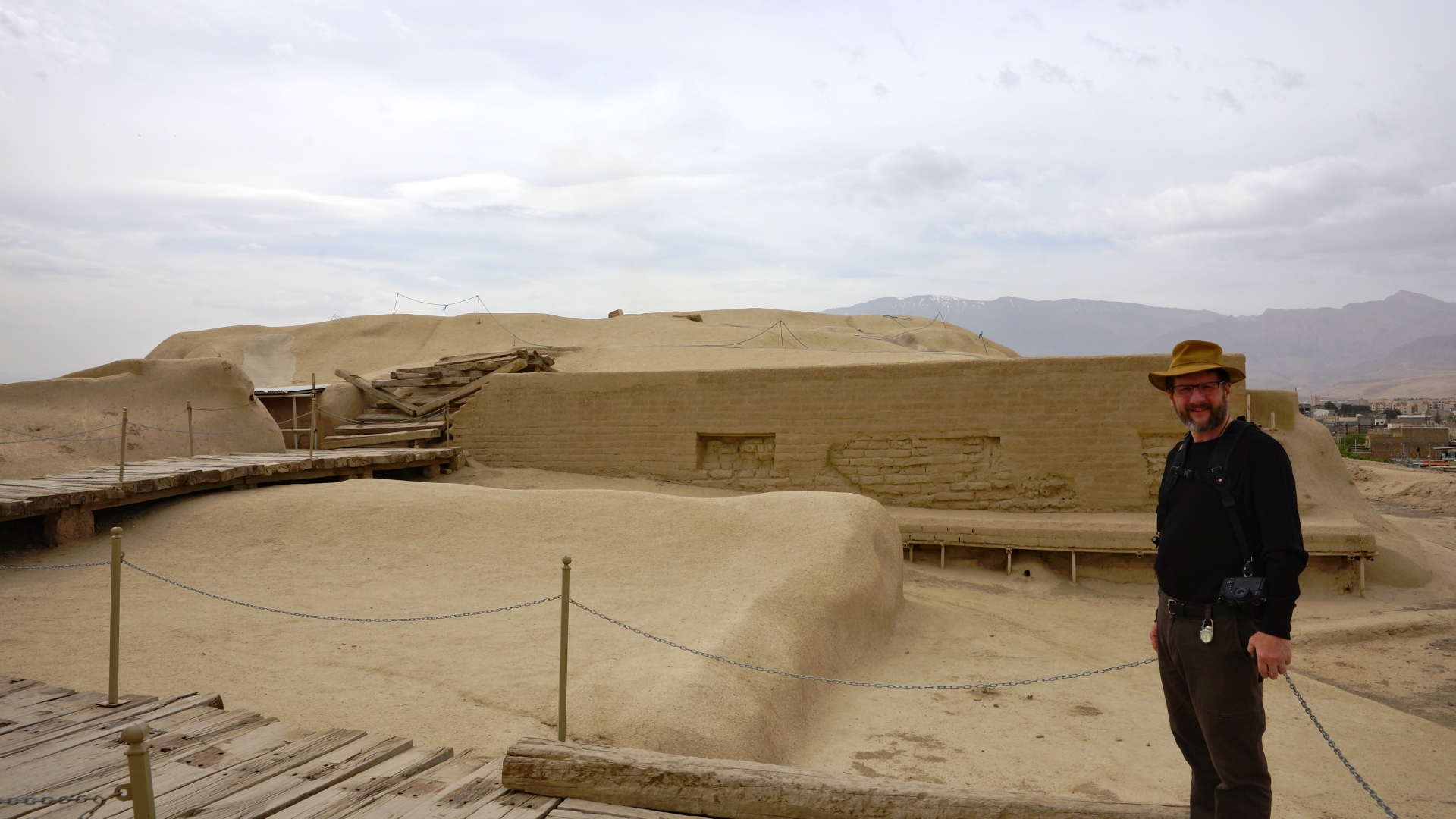
Author
on opposite side of first photo at Tepe Sialk
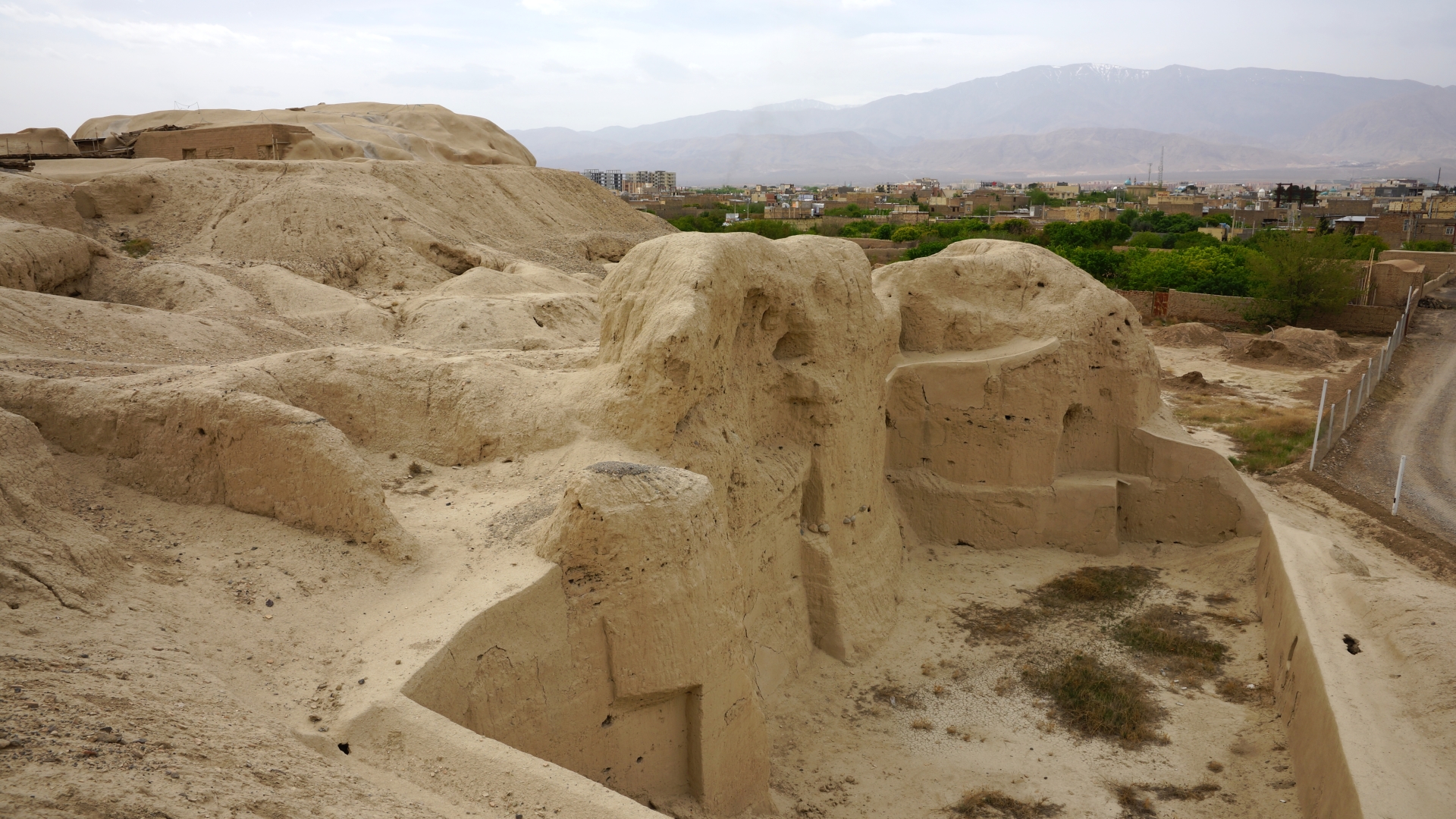
Moving
further away from previous photo. Shows area the rich and
powerful lived in.
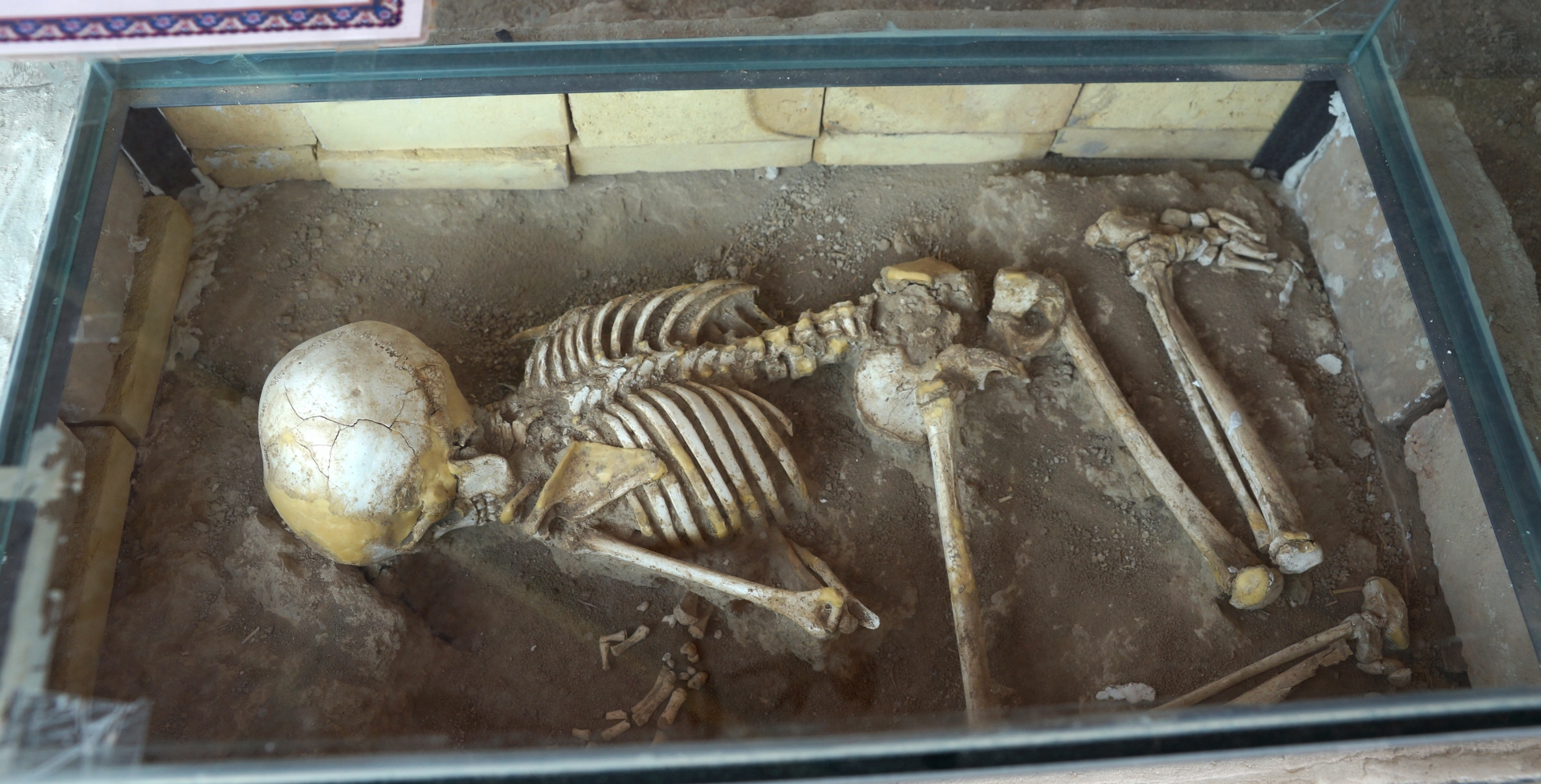
Burials
near Tepe Sialk
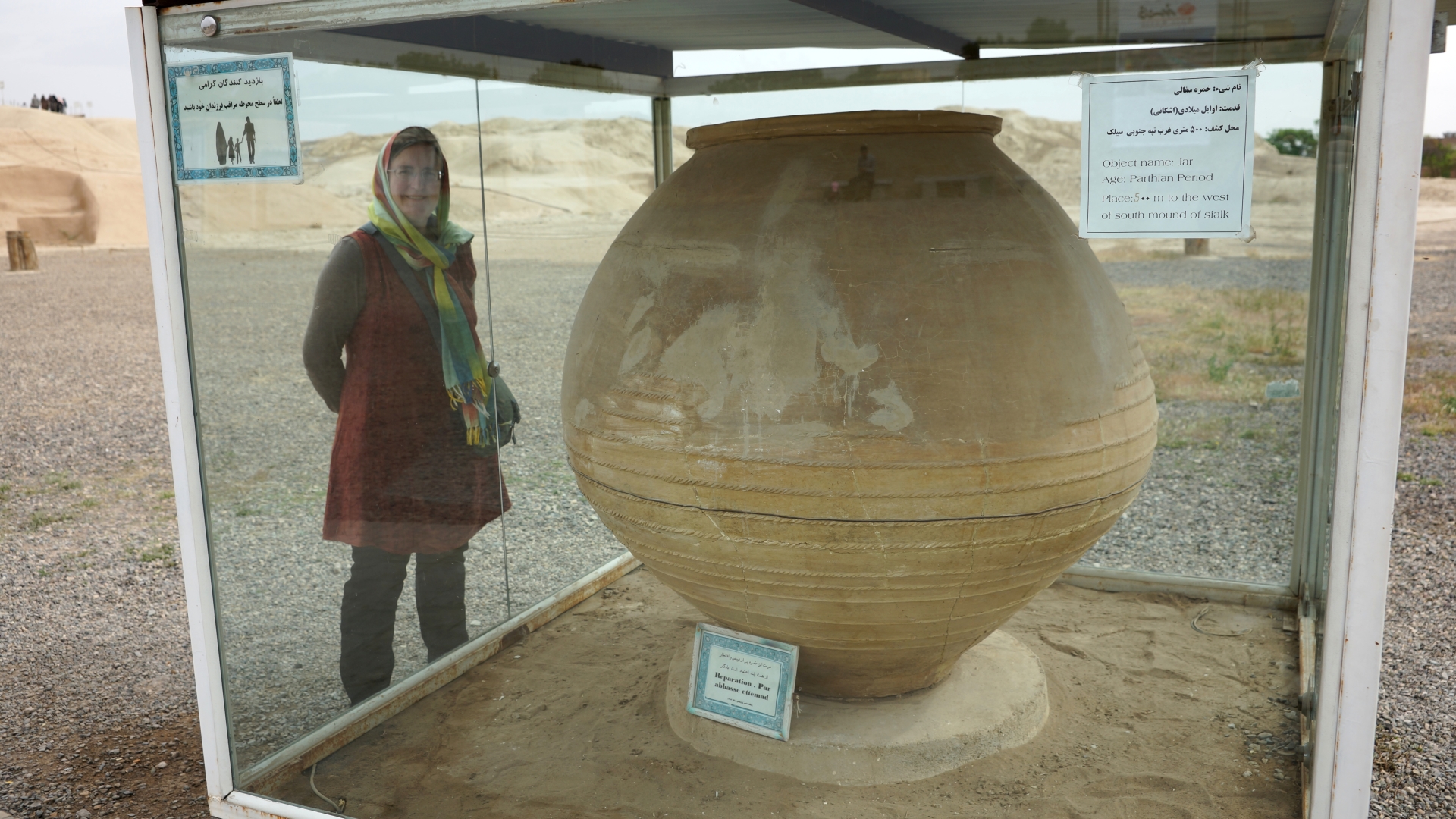
Reconstructed
pot used at Tepe Sialk
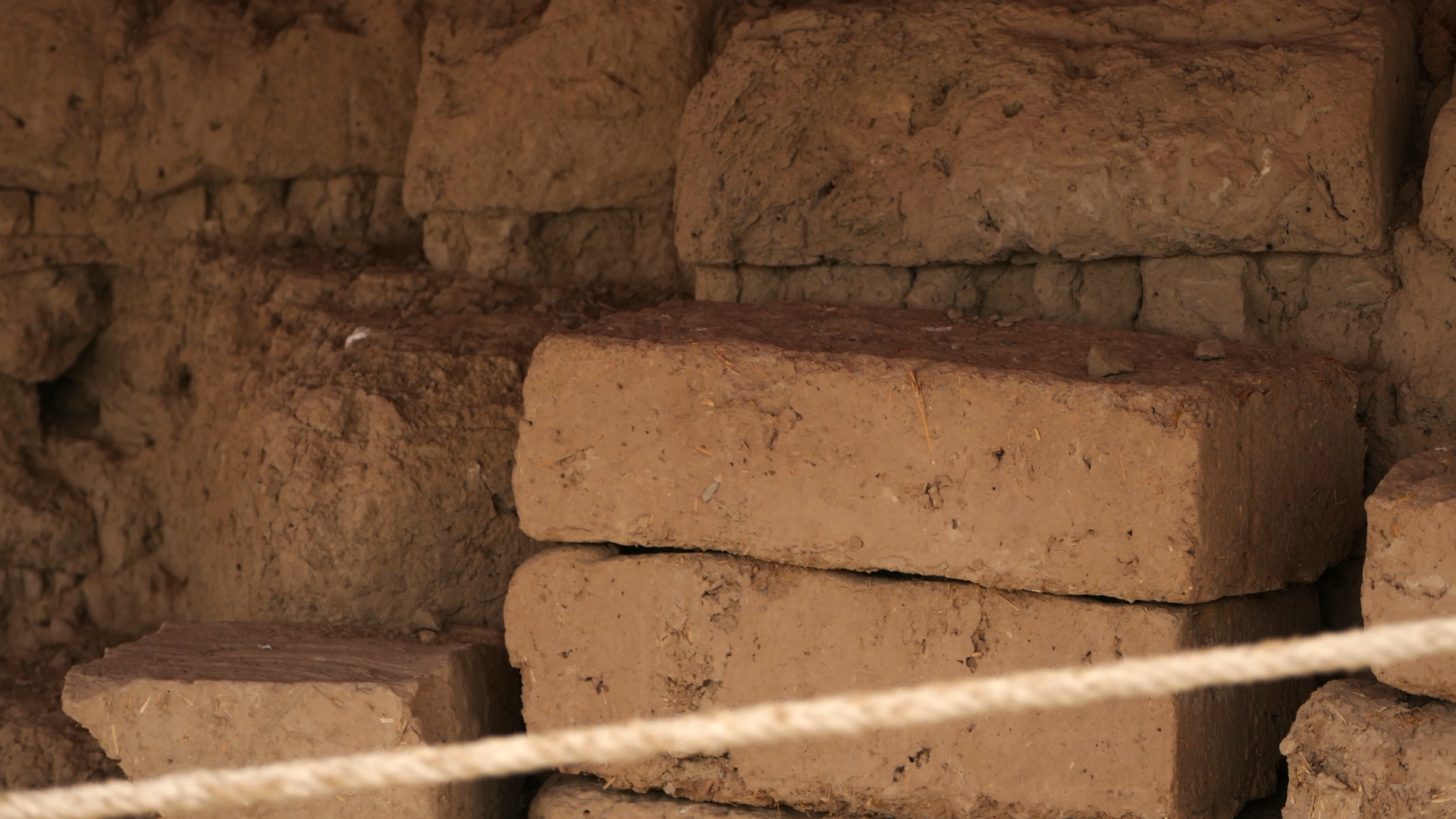
Mud-brick
(with straw) used to construct Tepe Sialk (assuring this is not the
site of Babel)
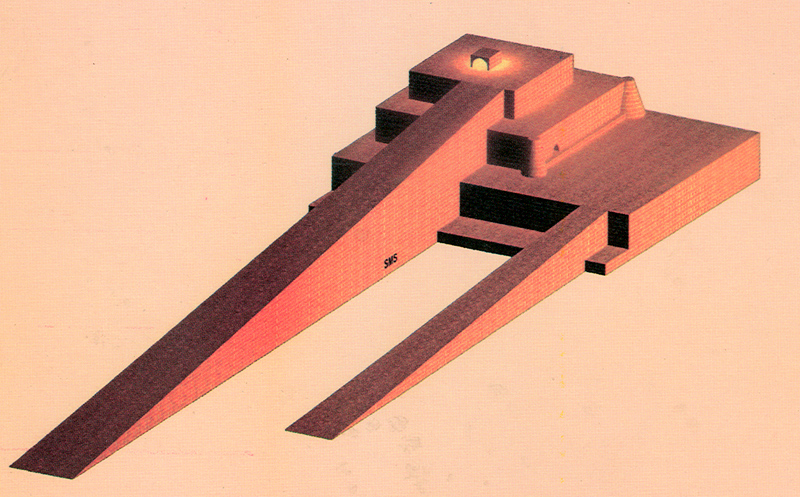
CAD
rendering of original shape of Tepe Sialk
|
|
Chogha Zanbil
Contrasting
Tepe Sialk, Chogha Zanbil was one of the last ziggurats built.
Like all ziggurats before it, the people viewed Chogha Zanbil as a
stairway to heaven. King Untash-Napirisha built it, around
1,250 B.C., to honor the great god Inshushinak. Sun-baked
bricks made up the solid core of the building, with facings of fired bricks.
It survived until 640 B.C. when the Assyrian king Ashurbanipal
destroyed it.
Untash-Napirisha
built Chogha Zanbil on high ground, more than fifty meters above the
nearby river Dez River, which made it difficult to bring water to the
surrounding city. The king's solution betrays his ambitions to
surpass Susa. He ordered his people to build a canal to Susa,
diverting freshwater from the Choaspes river (Karkheh). It passed
along Haft Tepe, diverting into nine branches, and finally reached
the town. Unfortunately, the arriving water was full of
mud and, because it was downstream from Susa, not very healthy.
Cleaning it became necessary before use at Chogha Zanbil. Therefore,
he built water purification refineries (using tar for waterproofing),
conducting the water through several basins. By today's standards
this is still a remarkable piece of engineering. The one excavated
refinery is the oldest known water purification building in the world.
Chogha Zanbil is the best preserved Ziggurat in Iran and, indeed, in
the entire region.
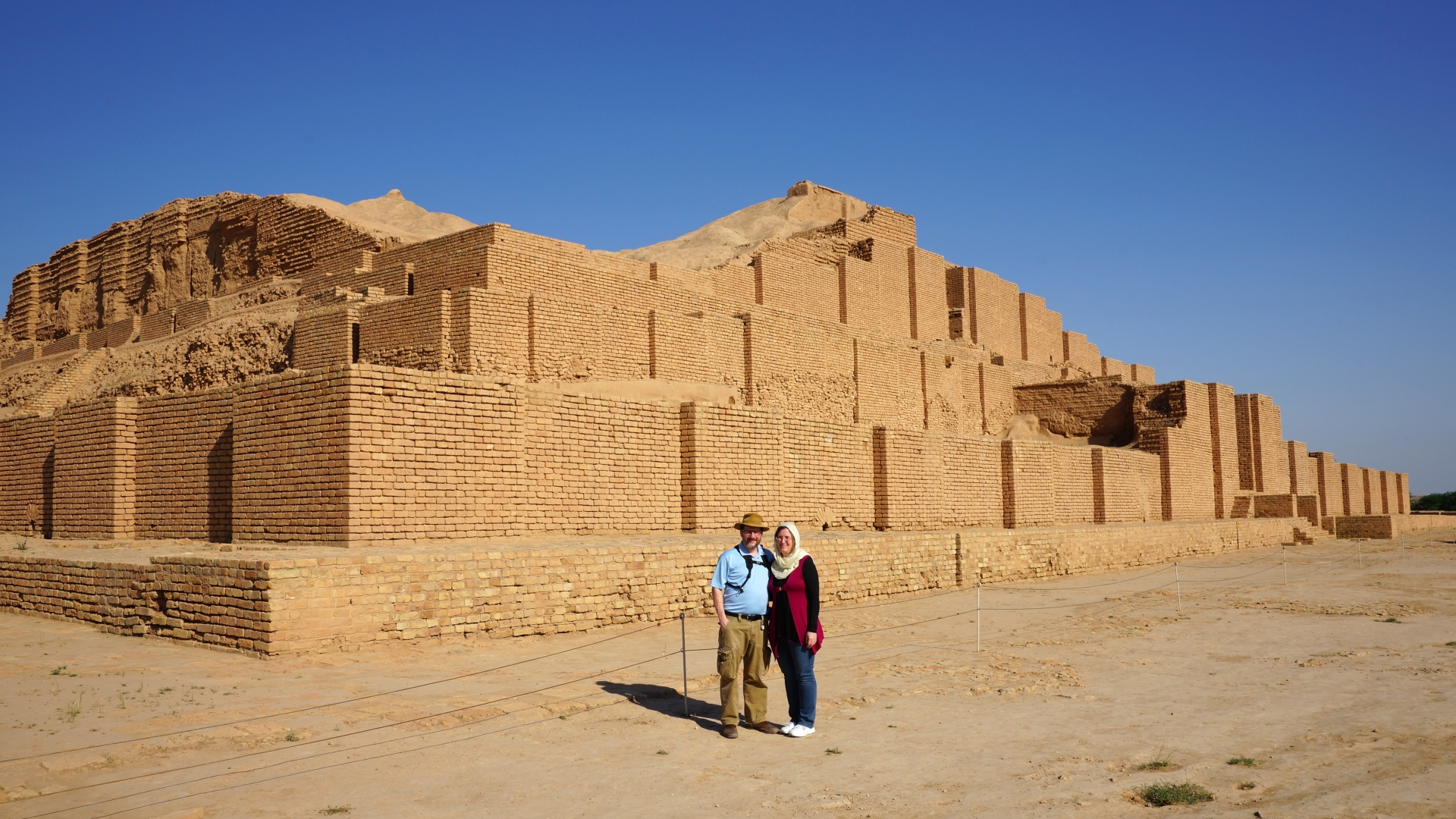
The
author, Brent, and his wife Angie at Chogha Zanbil
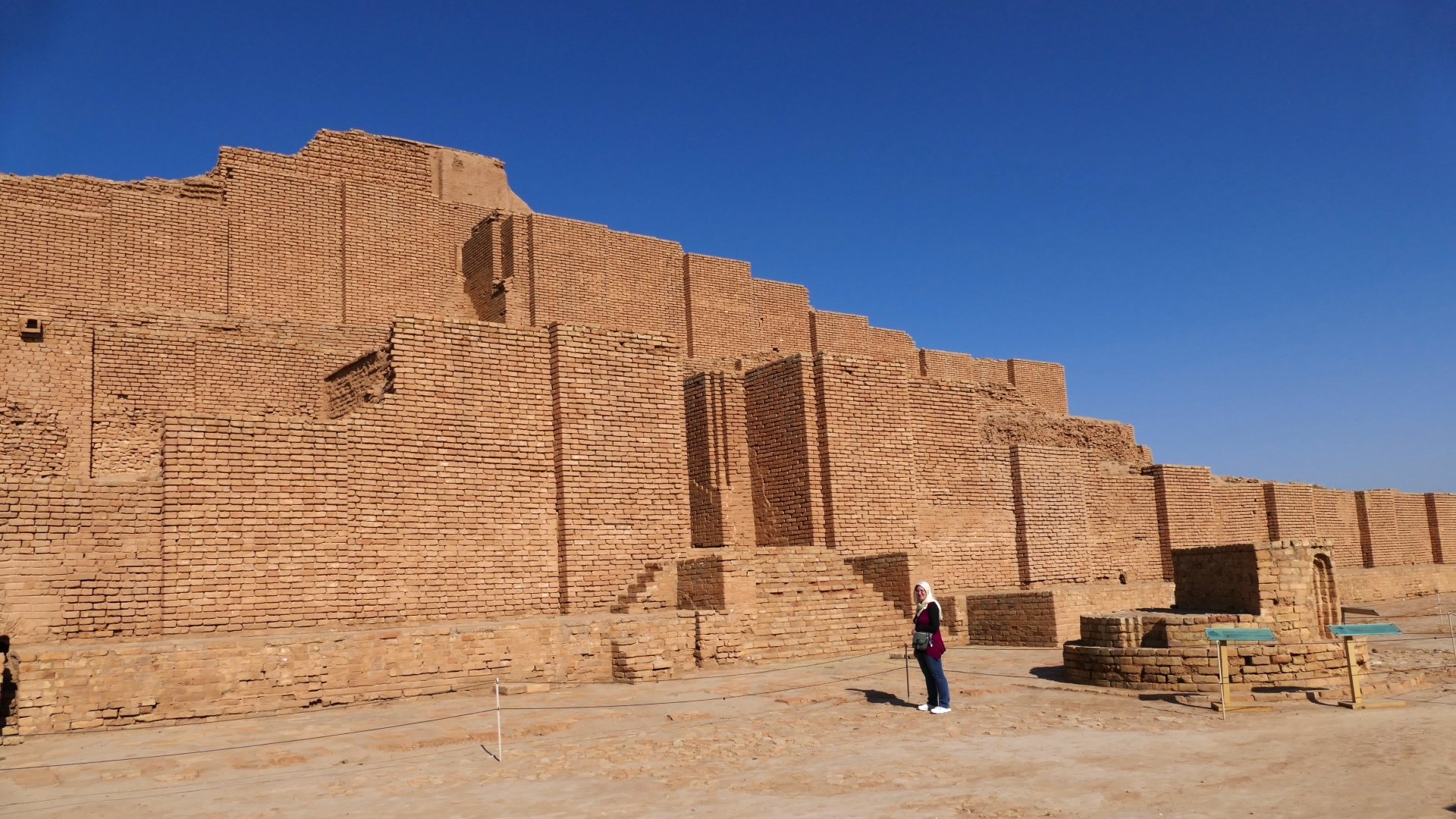
The
author's wife near wear the central stairs go up at Chogha Zanbil
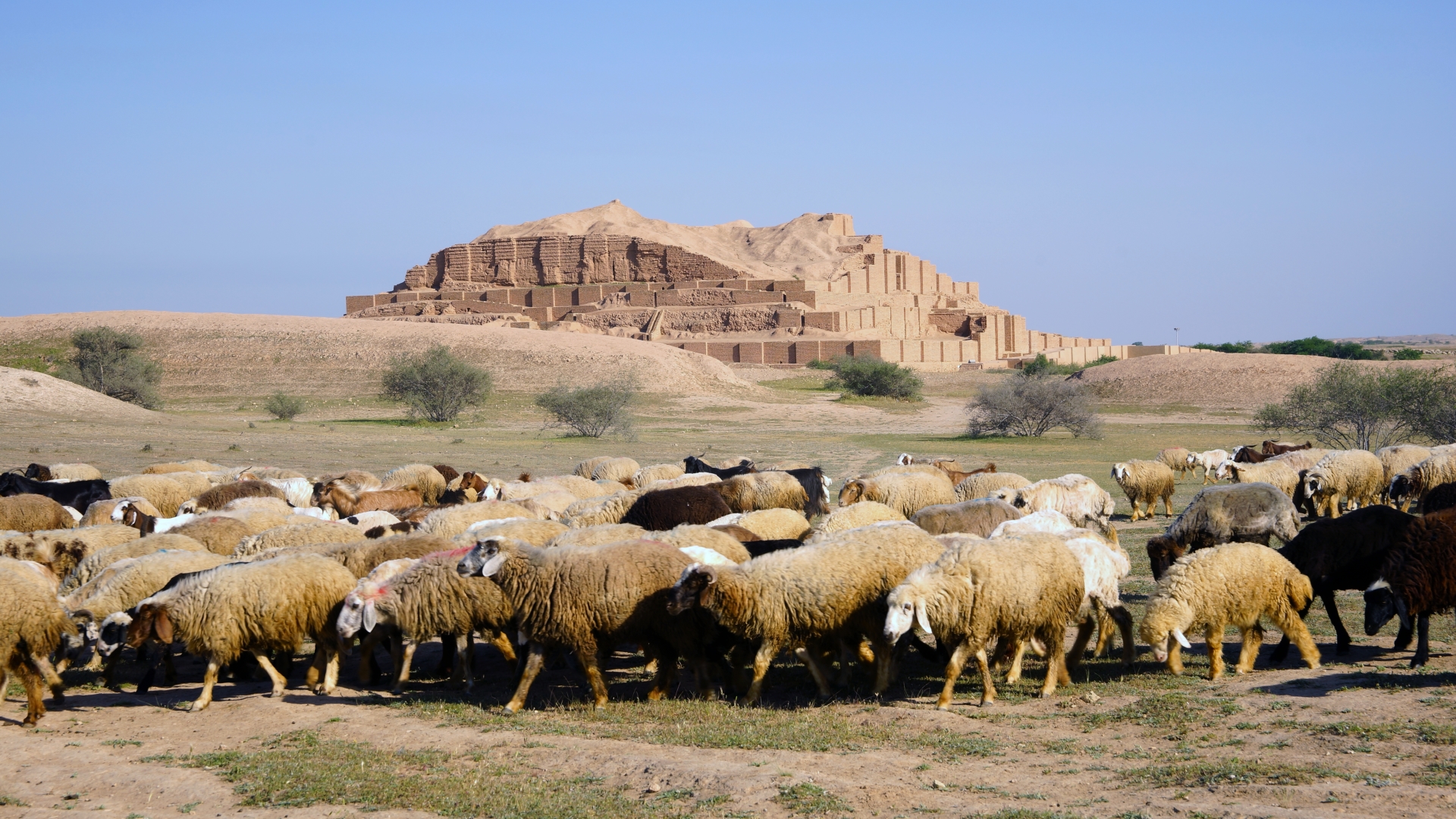
Chogha
Zanbil from a distance
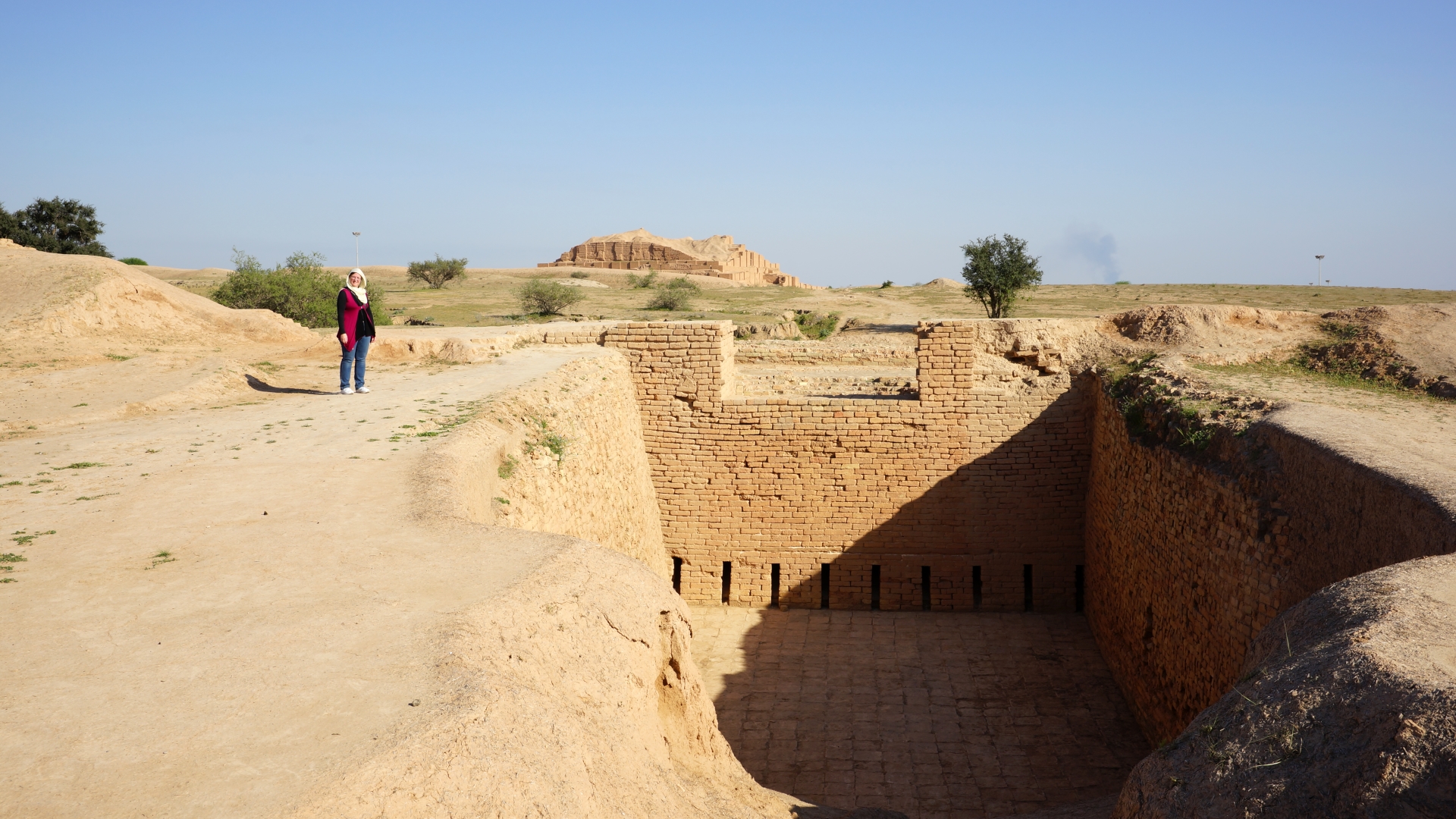
Chogha
Zanbil's water purification system
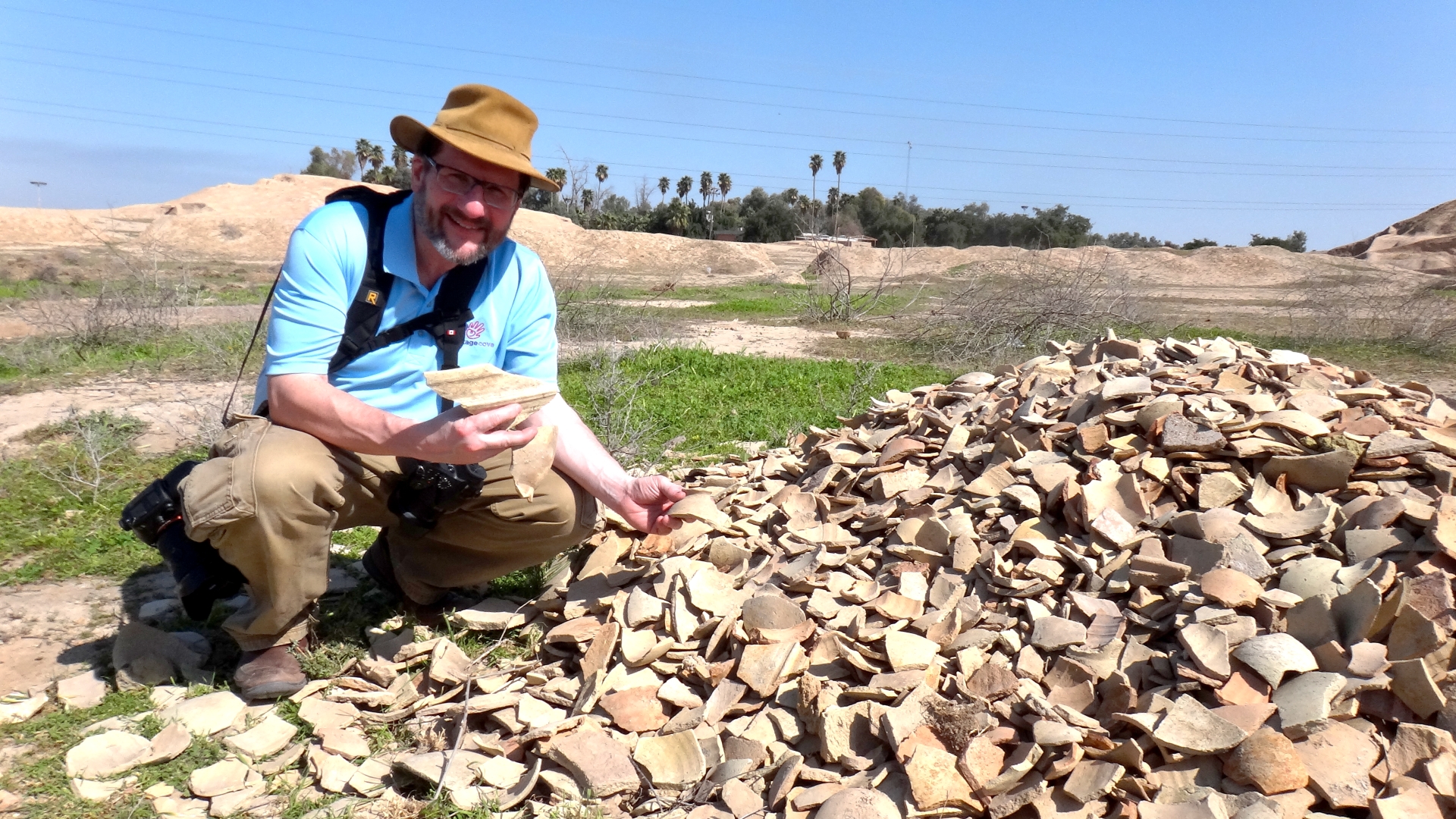
The
author examining pottery at Chogha Zanbil's nearby royal burials
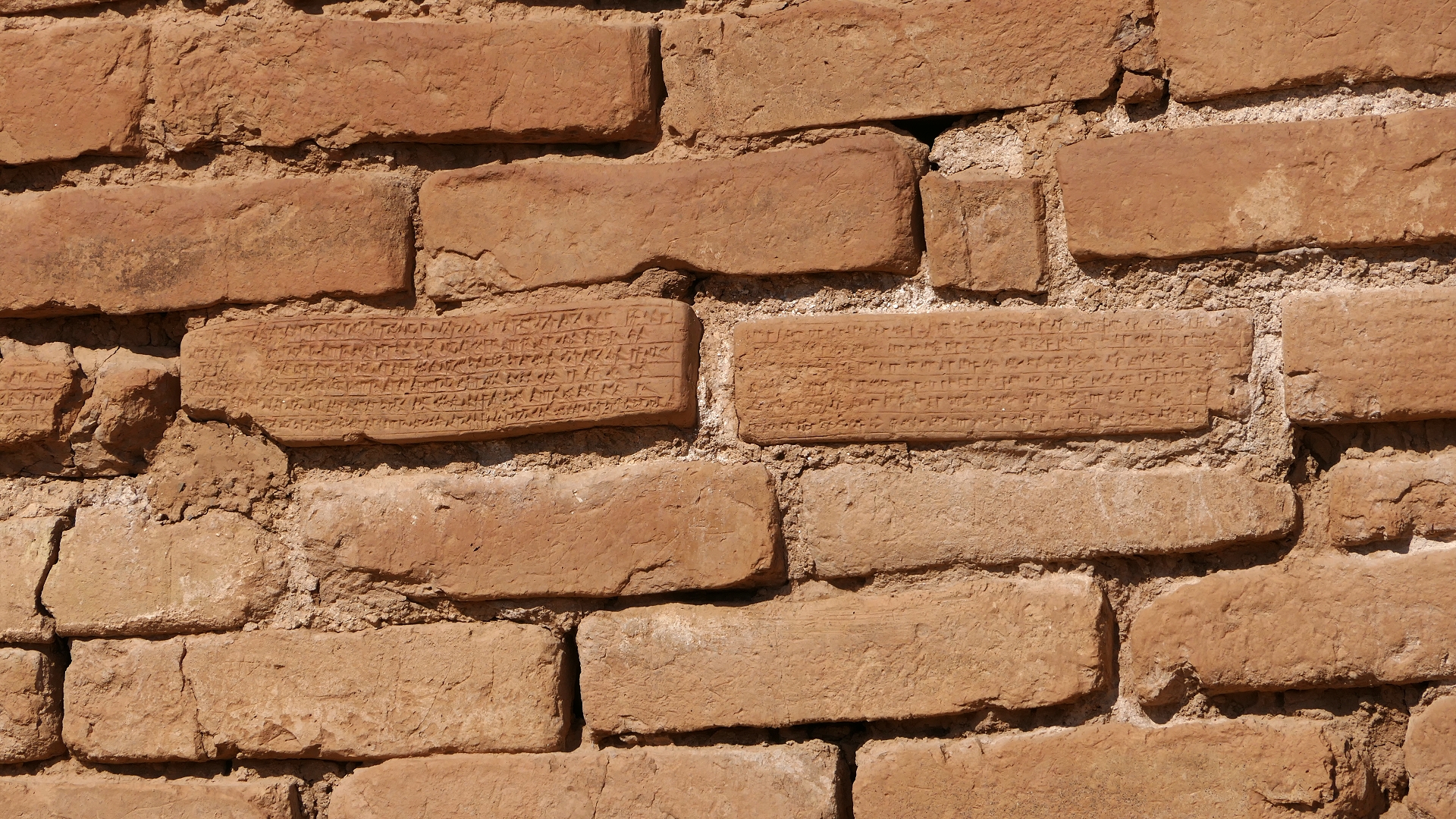
Chogha
Zanbil's fired bricks, some with cunieform inscriptions
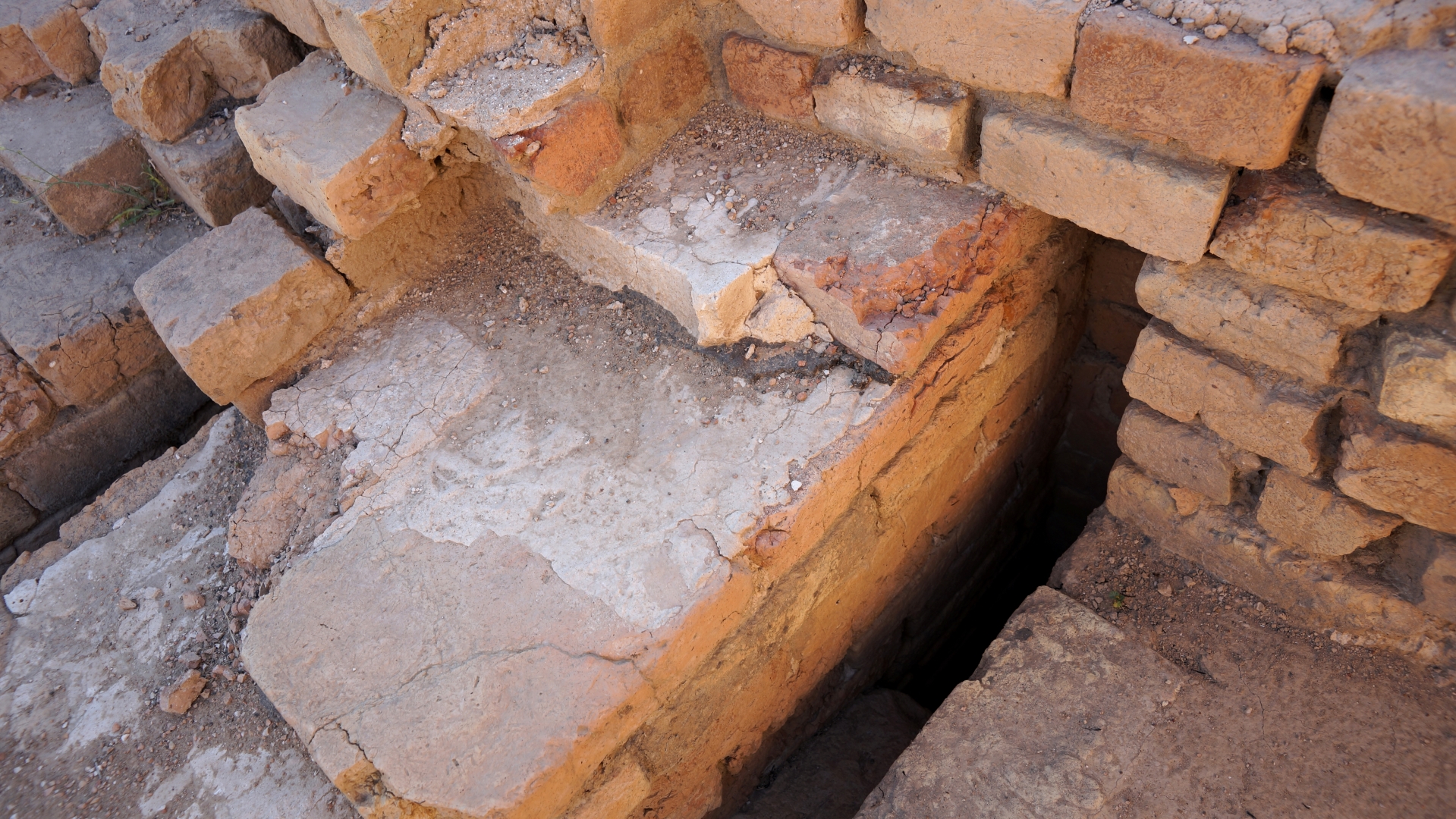
Some
of Chogha Zanbil's bricks using tar for mortar.

A
bull found in pieces near the stairway at Chogha Zanbil
(now
at the national museum in Tehran)

Artist's
rendering of Chogha Zanbil as built
|
|
Etemenanki (Babylon)
The most
famous ziggurat, called Etemenanki, was central to the huge city of
Babylon itself. It honored the god Marduk. Its rebuilders, king
Nabopolassar and king Nebuchadnezzar II, claimed that it reached into heaven.
We know little of the older ziggurat existing here during Hammurabi's
reign (B.C. 1792-1750). Most feel Hammurabi had this ziggurat
built during his reign. Perhaps he built over a still earlier
ziggurat, but this is speculation without evidence. In line
with that speculation, some assert Babylon founders were Sumerians,
noting that an early tablet records Sargon of Akkad (ruled 2334 -
2279 B.C.) rebuilding Babylon.
Many
records mention the ziggurat of Nebuchadnezzar II's reign (ruled
605-562 B.C.). This was the ruler who deported the Jews from
Israel. The previous ziggurat already was old when he took power and
in need of restoration. Its Sumerian name was
"Etemenanki," meaning "House of the platform of heaven
and earth," "Temple of the foundation of heaven and
earth," or "House of the platform between heaven and earth."
The condition of the final, rebuilt, ziggurat also declined and was
in ruins (by 331 B.C.) when Alexander the Great arrived.
Unfortunately, little survives of this massive building, including
the base. People commonly refer to the few surviving bricks,
each with an identifying stamp of Nebuchadnezzar, as "Tower of
Babel bricks" or Nebuchadnezzar II bricks.

Artist
rendering of Babylon with its central ziggurat
A
discovered tablet provides us most measurements of this Babylon ziggurat:
1st step
300ft by 300ft 110ft high
2nd step
260ft by 260ft 60ft high
3rd step
200ft by 200ft 20ft high
4th step
170ft by 170ft 20ft high
5th step
140ft by 140ft 20ft high
6th step ???
by 20ft high???
7th step
70ft by 80ft 50ft high
The scribe
omitted the measurements of the sixth step but its height likely
mirrored the three previous at twenty feet. Together it places
the top temple of the ziggurat at three hundred feet high. The
core of the building was trodden clay (equivalent to sun dried
bricks) with a layer of fired bricks on the outside. Priests reached
the top of the ziggurat using a broad stairway going up the side.
This stairway was thirty feet wide. Buildings surround the base of
the ziggurat, these included storerooms, accommodation for priests
and others connected with the temple.
Many see
Babylon or a nearby city as a primary candidate for the site of Babel.
The nearby site is called Birs Nimrud or Borsippa (about 18 km or 11
miles southwest of modern Babylon). It too was rebuilt in by
Nebuchadnezzar II. He wrote of the previous tower at
Borsippa: "A former king built the Temple of the Seven Lights of
the Earth, but he did not complete its head. Since a remote time,
people had abandoned it, without order expressing their words. Since
that time the earthquake and lightning had dispersed its sun-dried
clay; the bricks of the casing had been split, and the earth of the
interior had been scattered in heaps." (Cuneiform Borsippa
inscription of King Nebuchadnezzar)
Pros and
cons of behind selecting Babylon or Borsippa...
Pros.
1. Babel
and Babylon are spelled with the same three letters in Hebrew (Bbl).
Babylon is
the Greek variant of the Akkadian "Babilu (Bbl)," an
ancient city in Mesopotamia. It was the "holy city" of
Babylonia from early times. Akkadian "bab-ilus" means
"Gate of God," translating the Sumerian "Kadingirra."
2. The
land of Shinar is later associated with the kingdom of Babylon in
Nebuchadnezzar's time - consider Daniel 1:1-2 & Zechariah 5:11.
3. Reference
points in Scriptures show Babylon and Borsippa within the area
associated with the land of Shinar.
4. Minimalist
Bible scholars, disputing the historicity of an actual Tower of
Babel, believe the Jews in captivity saw the Babylonian tower and
used it as a basis for the original story.
5. Birs
Nimrud retains a tie to the Bible's Nimrod.
6. Borsippa
was a Greek name for the site; it means "tongue-tower."
7. There
was a large ziggurat at both locations.
8. Later
Talmudic sources and Arabic culture both associate Borsippa (Birs
Nimrud) with the Tower of Babel.
9. First
century historian Josephus claims that Babylon is Babel (Antiquities
of the Jews, book 1, chapter 4).
10. The
original ziggurat at Birs Nimrud was left unfinished.
11. Babylon
shows up in eschatology (incl. Revelation chapters 14, 16 & 17)
Cons.
1. Babel
and Babylon come from words meaning something completely different.
The Bible clearly says (Genesis 11:9) that Babel comes from the
Hebrew etymology, sounding like the Hebrew word "balal"
meaning confused. Without original vowel sounds, which original
Hebrew did not include, there is no certainty that both words were
the same. The Sumerian name for Babylon had nothing to do with "confusion."
Rather, as with all ziggurats, its name emphasized the "Gate of God."
Some even change the etymology of the Hebrew Babel, claiming Bab-El
means "Gate-God" to try and bring these together.
This goes against the Biblical text and utilizes a word for gate not
commonly used in the Old Testament (gate is normally
"sha'ar" in Hebrew and exclusively so in Genesis).
2. Babylon's
association with the land of Shinar, in later Bible times, shows
that the region is correct, not necessarily the city. The late
use only confirms Babylon as the leading city of the region in that day.
3. Birs
Nimrud was a lesser ziggurat than Babylon's, dedicated to the local
god Nabu, the "son" of Babylon's greater "Marduk."
Admittedly, we don't know what god it was dedicated to when
originally built.
4. Unless
there was a third, much earlier, ziggurat at Babylon, it dates too
late to be a viable candidate for the Tower of Babel. Without
any extant evidence, we can only speculate how old the original
ziggurat was at Birs Nimrud.
5. Late
sources, such as the Talmud and, especially, Islamic sources are
notoriously unreliable. Muslims frequently invent traditions in
competing locations based on very loose associations or none whatsoever.
6. Josephus
is mostly accurate on events in his time but uses traditions and
dubious sources to augment earlier history. The Babylonian
tradition was relatively recent and admittedly rooted in the Land of
Shinar's later association with Babylon (readily seen by Josephus'
cited sources and examples). He included the mythical claim the
people wanted to "build a tower too high for the waters to be
able to reach," waterproofed by using tar. His writings
spread belief that Babel's purpose was to escape another flood.
Ziggurats
of Ur
Ur-Nammu
(reigned 2112-2095 B.C.), a late Sumerian king of Ur, built some of
the earliest ziggurats in Mesopotamia. Ur-Nammu's were with three
"steps," later Ziggurats had as many as seven "steps."
The original Great Ziggurat of Ur (located by Nasiriyah in Iraq's present-day
Dhi Qar Province) was of this early design. While started by
Ur-Nammu, King Shulgi (reigned 2094-1982 B.C.) finished this ziggurat.
Shulgi, to win loyalty of the cities, also proclaimed himself a god.
Its Sumerian name "Etemenniguru" means "temple whose
foundation creates aura." This tower honored the patron
deity of Ur, the moon god Nanna or Sîn. By the sixth
century B.C. it had fallen into ruins but King Nabonidus (co-regent
with Belshazzar) restored it during the Neo-Babylonian era.
Records show King Nabonidus, after "finding little left but the
last stage and nothing to guide him as to the monument's original
appearance," had it restored in seven stages rather than the
original three.
The large
step pyramid measured 64 meters (210 ft) in length, 45 meters (148
ft) in width and over 30 meters (98 ft) in height. The
calculated height is speculative, with only its lower foundation surviving.
The
present remains of the ziggurat consist of a three-layered solid mass
of mud brick faced with fired bricks set in bitumen tar. The lowest
layer dates to the original construction of Ur-Nammu, while the
remaining two upper layers are part of the Neo-Babylonian restorations.
|
|
The Bible's Tower of Babel
The Biblical text does provide many specifics and clues to
circumstances surrounding the events of Babel.
One worldwide language?
The people all spoke the same language (Genesis 11:1). The
occupants of Noah's Ark shared one language from a single language family.
And yet, isolation of populations results in new languages.
During the hundreds of years following the flood, most people staying
close to one another would preserve this core language family. It is
not unreasonable to expect that accents or unique pronunciations
arose within subgroups, especially those rather remote from the main group.
Like all living languages, overall even the original would continue
to change and expand over the years. Peoples leaving the core
group would potentially develop language variations and, remaining
isolated, even new languages.
Genesis chapter 10 implies that descendants of Noah's family spread
out from one another in the years following the flood. The
Biblical text provides no sign of delayed scattering until after
Babel, though some cited generations followed the time of Babel. The
primary people group in view in Genesis 11 continues to be
descendants of Shem.
English translators common present Genesis 11:1 as "Now the
whole earth had one language and the same words." This
does not mean the entire world remained the same language. The
word translated "earth" equally translates as "land."
The "whole land had one language" referred to the primary
people group that had remained together following the flood, then
living east of Shinar.

(Left)
Expected language pattern by evolutionary development.
(Right)
Expected natural language development interupted by Babel
The land before the westward migration.
The people who built Babel migrated from the east (Genesis 11:2),
obviously having first moved south and east from the region of Ararat
following the flood. The "east" meant the people
previously occupied the central to southern region of modern Iran,
slightly north or within the area later called Elam.

Did 100% percent of the people move east?
Noah's descendants lived for many years in the regions they passed
through after the flood. Nothing in the text says they all
moved on. The Hebrew of Genesis 11:2 only references eastward
migration (most English translations supply the word
"people" to clarify the Hebrew). Those migrating
become the focal point of the continuing verses. We can
reasonably assume some would stay in villages founded during their
time in previous regions, even during a majority migration westward.
People usually migrate for a reason; because of war, famine,
overcrowding, or want for better circumstances. The text does
not give us their motivation.
Was the Tower of Babel the first tower ever built?
The idea to build a city and tower was not necessarily new (Genesis 11:4).
They likely, previously, built both in areas they lived before their
latest migration. Remember, over 500 years had elapsed since
Noah's flood spanning many generations living in some areas.
Population growth would have easily filled cities (often Biblically
much smaller than today's cities). There was nothing new in the
idea of a tower for religious purposes, likely something experimented
with previously. Archaeology supports this as the ziggurat at
Tepe Sialk predates the Tower of Babel.
Was the tower of Babel unique?
The Bible shows the Tower of Babel different from earlier and later
Ziggurats on several issues. The tower's size and design were
irrelevant; some later Ziggurats may have been larger. The
Bible focuses on the people's intent and the tower's purpose.
They wanted a name. This people group wanted fame and
long-lasting recognition (Genesis 11:4). All empires want this!
Their independence from God fueled their goal, focusing on themselves
as supreme. They hoped the renown of their city and tower would
encourage people to stay together in the region, remain under their
leadership, and honor the tower's builders. A permanent legacy
and remembrance was their goal. (The Bible similarly uses
"name" in Genesis 6:4 and later in Genesis 12:2).
Apart from God confusing their language, forcefully creating a
cultural division splitting apart the peoples of the region, their
goal of unity under a lie would have succeeded (Genesis 11:6).
Image the following picture. One large people group, of common
language and culture, successfully creates and promotes a religion,
complete with an inspiring destination for religious pilgrimage (like Mecca).
As they grow in size and strength they assimilate the few surrounding
peoples, nowhere close in size or developed culture (mostly
fragmented groups broken off from the main after the flood).
The result is one huge empire, fueled by a common national language
and mandated religion. Babel's people planned for this, only
thwarted by a God-ordained restraint. His linguistic and
cultural division of the peoples in the region stopped this
homogeneous empire and provided time for counterbalancing empires to
arise elsewhere.
They wanted self-sufficient unity. Their source of power rested
in the strength and unity of one massive people rather than God.
They believed an all-powerful people could do anything by sticking together.
Language and cultural divisions have been a major source of downfall
for all following empires. The people of earth have since
remained divided. (In contrast, God's worldwide kingdom
transcends language and culture).
The city's power and magnificence of its tower would prevent people
from scattering. God's original plan for humanity was to
"be fruitful and increase in number; fill the earth and subdue
it" (Genesis 1:28, also repeated to Noah and his family in
Genesis 9:1). Babel's city and tower promoted collective
rebellion against God from one location. Political force
upholding their false religion compelled compliance as part of the
ambition of their widespread empire. The events of Babel,
tearing apart this empire, displayed God's sovereignty over the
governments of the earth (Romans 13:4).
The tower's "top in the heavens" used spiritual matters to
manipulate the people. This expression uses spiritual wording.
The top of the tower spiritually reached into the heavens, home of
the gods. The earliest built tower with similar purpose, the
Tepe Sialk Ziggurat, featured a shrine for god at its top. This
Ziggurat, at Kashan, Iran, is almost due east of Baghdad and nearby Babylon.
The migrating people, later building Babel, brought the ideas behind
Sialk's design with them to Mesopotamia. This part of their
belief system regionally continued after Babel. They believed
the tower's top was a gateway to the gods. Humanity's religion
is always trying to reach into heaven (Romans 10:6).
Christianity is different because God came to us (John 3:13).
God gives Jacob, when leaving the land of Israel to go to
Mesopotamia, a vision of a stairway reaching into His heaven (Genesis 28:10-13).
Some English translators use "ladder" but context better
shows it to be a stairway. God clearly appeared above it
(Genesis 28:13) showing Jacob that He alone is the God of heaven.
During Jacob's continued journey eastward (Genesis 29:1), he would
recognize these man-made stairs to heaven (Ziggurats) as meager fakes.
Human priests hiking staircases of a Ziggurat pale in comparison to
angels rising and descending from God heavenly home. Jacob
recognized God's stairway as the "gate of heaven (Genesis 28:17)
before he even saw an Akkadian "bab-ilus" or "Gate of God."
Babel's construction style.
Babel's builders used fired bricks instead of stone and tar for mortar.
The earlier mud-brick Ziggurat at Tepe Sialk would have lacked
strength and longevity. Quality building stone was rare in
Mesopotamia, so mud bricks (both sun dried and fired) were a common substitute.
Fired bricks were more labor-intensive and expensive. Babel's
use of fired bricks should a great commitment of time and expense.
Plus they were planning for a lasting monument. Similarly,
stacked bricks without mortar are not as strong. Natural tar
was readily available in this oil-rich region in Iraq. Later
Ziggurats, such as Chogha Zanbil and the Great Ziggurat of Ur, show
continued use of tar in their construction.
Confused language - New languages
God confused the people's language; meaning new unrelated languages
came on the scene. The people groups in the east, once sharing
a language with the builders of Babel, provide a great example.
There are more than 74 languages still spoken in Iran, as a first
language, representing 7 different language families (or primary branches).
For comparison, 10 language families represent 76% of all the world's languages.
The former land of Shinar, Iraq, has 23 spoken first languages.
These statistics don't include the now extinct languages of the
Sumerians, Akkadians or Elamites. The entire region shows great
representation of language diversity and fragmentation expected after
a major event introducing multiple new root languages into the region.

Language
map of present day Iran
Will archaeology prove which place is Babel?
The tower was at a place later called Babel (Genesis 11:9).
It's original or intended name is unknown. If written records
or inscriptions exist at the site, they likely carry the original
name of the place. Slight possibility exists the site includes
writings following God confusing their language. Their
abandonment of the tower may have included abrupt abandonment of the
area (Genesis 11:8). Any early Sumerian site in Iran featuring
a Ziggurat of fired bricks with tar mortar is a possible candidate,
especially if the tower was incomplete. Unfortunately, because
of the cost and scarcity of fired-bricks, it's equally possible later
people scavenged the site for its bricks.
The influence of Babel
Ziggurats are the earliest known pyramids. Later pyramids, such
as those in Egypt and Mesoamerica, existed for spiritual purposes as well.
Either early people held some memory of these first towers, or they
were under similar influences to craft comparable. Some of
these buildings did not come on the scene until thousands of years later.
Differences and likenesses to the earlier Ziggurats include:
Egypt - Egyptian pyramids are stone and not mudbrick. The first
pyramids are of stepped design, closer in shape to Ziggurats.
The pyramid was never a temple, rather temples were separate.
These were burial monuments presumably for guiding Pharaoh's spirit
to the afterlife.
Sudan - The Nubian pyramids of Sudan were similar in purpose to the
Egyptian. Also cut stone is the building material used. All had
smooth sides and many later pyramids were of much steeper angles than
Ziggurats or Egyptian pyramids and typically smaller too.
Aztec and Mayan - These later stone-built, stepped, pyramids have
similar designed to Ziggurats. Their purpose closely aligns
with Ziggurats too. The top level served as a temple, but a more
active traditional temple where priests offered sacrifices to the gods.
In conclusion
We have likely permanently lost the site of the original tower of Babel.
Once abandoned by its builders ("they left off building the
city"), it either fell into complete ruins or later people
scavenged it for materials. Possibility exists that a much
later generation built over the site. The design of Babel, and
its general purpose, came from earlier towers in the east, such as
Tepe Sialk. Its "top in the heavens" was belief the
top bridged heaven and earth. Later Ziggurats continued to draw
on the same traditions and design. Language and resulting
cultural divisions prevented any later Ziggurat from fulfilling the
original intent of Babel. The unity wanted by its builders
became impossible because of God's intervention. Some later
Ziggurats, such as Babylon, were central to great empires, but each
remained limited by cultural division and language. The
Biblical account is reasonable and fits nicely into the region's archaeology.
Article by Brent
MacDonald, (c) 2016
Lion Tracks
Ministries (a division of Cottage Cove's Discipleship Training Institute) |
|